M7U19WARM-UP
- 格式:ppt
- 大小:3.27 MB
- 文档页数:29

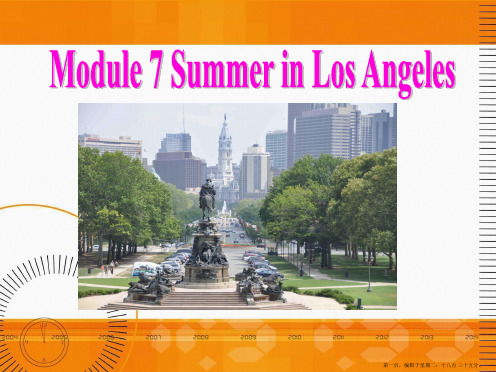
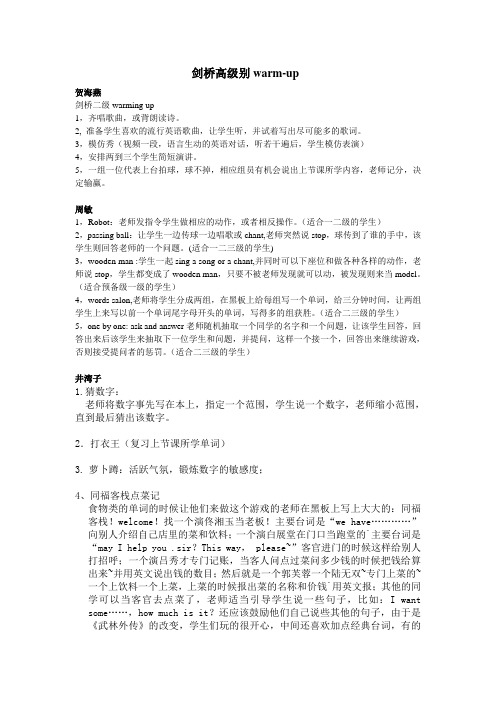
剑桥高级别warm-up贺海燕剑桥二级warming up1,齐唱歌曲,或背朗读诗。
2, 准备学生喜欢的流行英语歌曲,让学生听,并试着写出尽可能多的歌词。
3,模仿秀(视频一段,语言生动的英语对话,听若干遍后,学生模仿表演)4,安排两到三个学生简短演讲。
5,一组一位代表上台拍球,球不掉,相应组员有机会说出上节课所学内容,老师记分,决定输赢。
周敏1,Robot:老师发指令学生做相应的动作,或者相反操作。
(适合一二级的学生)2,passing ball:让学生一边传球一边唱歌或chant,老师突然说stop,球传到了谁的手中,该学生则回答老师的一个问题。
(适合一二三级的学生)3,wooden man :学生一起sing a song or a chant,并同时可以下座位和做各种各样的动作,老师说stop,学生都变成了wooden man,只要不被老师发现就可以动,被发现则来当model。
(适合预备级一级的学生)4,words salon,老师将学生分成两组,在黑板上给每组写一个单词,给三分钟时间,让两组学生上来写以前一个单词尾字母开头的单词,写得多的组获胜。
(适合二三级的学生)5,one by one: ask and answer老师随机抽取一个同学的名字和一个问题,让该学生回答,回答出来后该学生来抽取下一位学生和问题,并提问,这样一个接一个,回答出来继续游戏,否则接受提问者的惩罚。
(适合二三级的学生)井湾子1.猜数字:老师将数字事先写在本上,指定一个范围,学生说一个数字,老师缩小范围,直到最后猜出该数字。
2.打衣王(复习上节课所学单词)3.萝卜蹲:活跃气氛,锻炼数字的敏感度;4、同福客栈点菜记食物类的单词的时候让他们来做这个游戏的老师在黑板上写上大大的:同福客栈!welcome!找一个演佟湘玉当老板!主要台词是“we have…………”向别人介绍自己店里的菜和饮料;一个演白展堂在门口当跑堂的`主要台词是“may I help you .sir?This way,please~”客官进门的时候这样给别人打招呼;一个演吕秀才专门记账,当客人问点过菜问多少钱的时候把钱给算出来~并用英文说出钱的数目;然后就是一个郭芙蓉一个陆无双~专门上菜的~一个上饮料一个上菜,上菜的时候报出菜的名称和价钱`用英文报;其他的同学可以当客官去点菜了,老师适当引导学生说一些句子,比如:I want some……,how much is it?还应该鼓励他们自己说些其他的句子,由于是《武林外传》的改变,学生们玩的很开心,中间还喜欢加点经典台词,有的同学看菜太贵了还说“饿滴神啊!!”5、有黏性的胳膊目的:熟悉和区分I like...以及He\She likes...及其相应的否定形式。
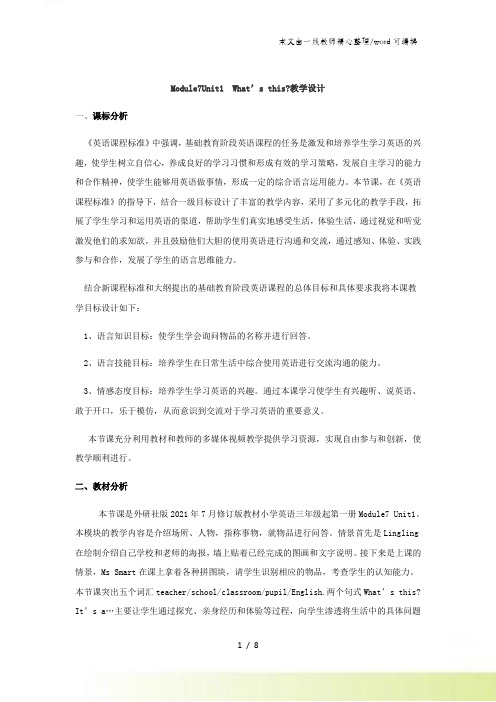
Module7Unit1 What’s this?教学设计一、课标分析《英语课程标准》中强调,基础教育阶段英语课程的任务是激发和培养学生学习英语的兴趣,使学生树立自信心,养成良好的学习习惯和形成有效的学习策略,发展自主学习的能力和合作精神,使学生能够用英语做事情,形成一定的综合语言运用能力。
本节课,在《英语课程标准》的指导下,结合一级目标设计了丰富的教学内容,采用了多元化的教学手段,拓展了学生学习和运用英语的渠道,帮助学生们真实地感受生活,体验生活,通过视觉和听觉激发他们的求知欲,并且鼓励他们大胆的使用英语进行沟通和交流,通过感知、体验、实践参与和合作,发展了学生的语言思维能力。
结合新课程标准和大纲提出的基础教育阶段英语课程的总体目标和具体要求我将本课教学目标设计如下:1、语言知识目标:使学生学会询问物品的名称并进行回答。
2、语言技能目标:培养学生在日常生活中综合使用英语进行交流沟通的能力。
3、情感态度目标:培养学生学习英语的兴趣。
通过本课学习使学生有兴趣听、说英语、敢于开口,乐于模仿,从而意识到交流对于学习英语的重要意义。
本节课充分利用教材和教师的多媒体视频教学提供学习资源,实现自由参与和创新,使教学顺利进行。
二、教材分析本节课是外研社版2021年7月修订版教材小学英语三年级起第一册Module7 Unit1。
本模块的教学内容是介绍场所、人物,指称事物,就物品进行问答。
情景首先是Lingling在绘制介绍自己学校和老师的海报,墙上贴着已经完成的图画和文字说明。
接下来是上课的情景,Ms Smart在课上拿着各种拼图块,请学生识别相应的物品,考查学生的认知能力。
本节课突出五个词汇teacher/school/classroom/pupil/English.两个句式What’s this? It’s a…主要让学生通过探究、亲身经历和体验等过程,向学生渗透将生活中的具体问题转化为英语思维的思想,让学生联系实际生活,达到英语真正语用的目的,继续激发学习英语的兴趣。

设计主题:M7U19 Lesson 1 Get Ahead with Your English 姓名:学校:性别:职称:教龄:联系电话:电子邮箱:指导老师姓名_单位__STEP 1 :Brainstorming:Free talk: In your opinion, how can he learn Chinese?What kind of letter are we going to write?A Letter of Advice【设计意图】写作为信息的输出。
本环节可以有效地帮助学生实现本课所学知识的迁移,真正做到知识的内化和产出,从而达到Anderson和Krathwohl认知领域中的高阶思维---语言创新。
所选的写作素材语境真实,微信视频播放激发学生兴趣,利于培养分析问题、解决问题能力。
学生通过小组讨论、分工合作,这样可以大量地节省时间。
Step 2 Peer-assessment and presentation <13 minutes>Exchange the letter, make assessment for each other and make presentationsItems Grades Total ScoreClear ideas 3 2 1Good layout 3 2 1Nice language 3 2 1Clear handwriting 3 2 1亮点最该改进的一点设计意图:引导学生根据评分标准对习作互动点评,碰撞学生思维。
通过班内展示、分享,为学生提供了充足的语言表达机会,突破思维定势,培养学生思维的灵活性、批判性和深刻性。
学生通过评阅他人的作文获得新的信息,学习好词句,发现共性问题,反省提高。
课堂同伴互评也有助于培养学生的批判性思维能力以及分析问题和解决问题的能力。
教师适时对学生的作品进行评价,把学生做不够好的地方加以指出以促进他们写作能力的提高。
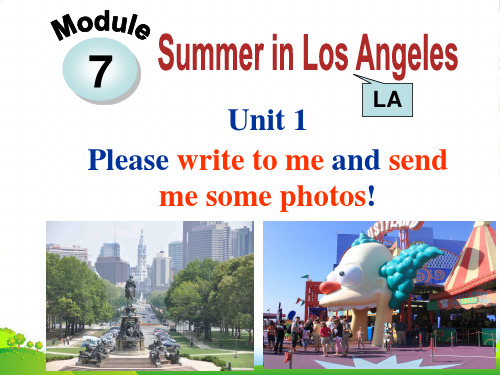
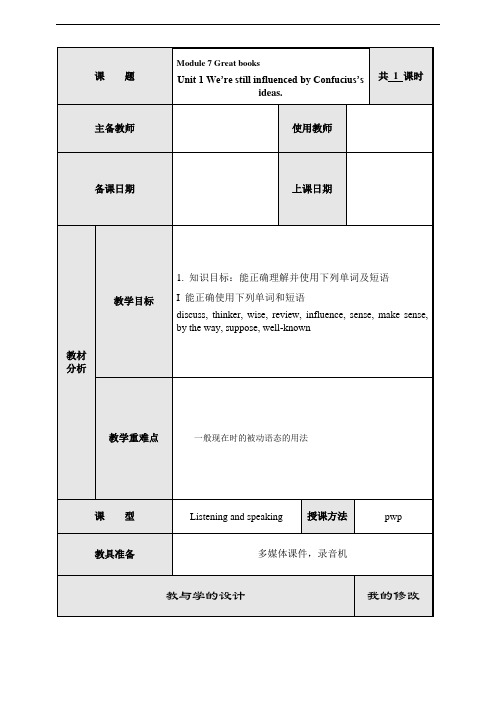
Chapter 1 Lead-in : Warming up and Revision(复习旧识,导入新课)Step 1 Lead-in标题导入:“Recently I’ve read a great book called Romeo and Juliet。
I’m deeply moved by it. Have you ever read some great books?”随即将“Great books”呈现在黑板上,鼓励学生说出他们读过的名著。
这里用学生们熟悉的话题导入新课,能够激发学生学习的兴趣,活跃课堂气氛,更重要的是通过老师的表述,如运用重读、稍慢的语速等方式强调被动语态的句子,让学生们在真实的语境中感知被动语态。
Chapter 2 The students can learn by themselves, and ask some questions about the study. (自主学习提出疑问)Step 2 Listening听activity1,展示三幅图片,问“Who are they? Do you know something about them? Try to use the words in the table to help you.”,学生们两人一组描述图片,之后,听磁带看学生们的匹配是否与所听到的一致。
1. Ask the students to Look at the pictures.2. Say who they are and why they are famous.3. Play the recording and ask the students to listen carefully.4. Now listen and check your answers.5. Ask the students to check their answer with a partner.6. Call back the answers from the whole class and check the answers. Step 3 Listening carefully。
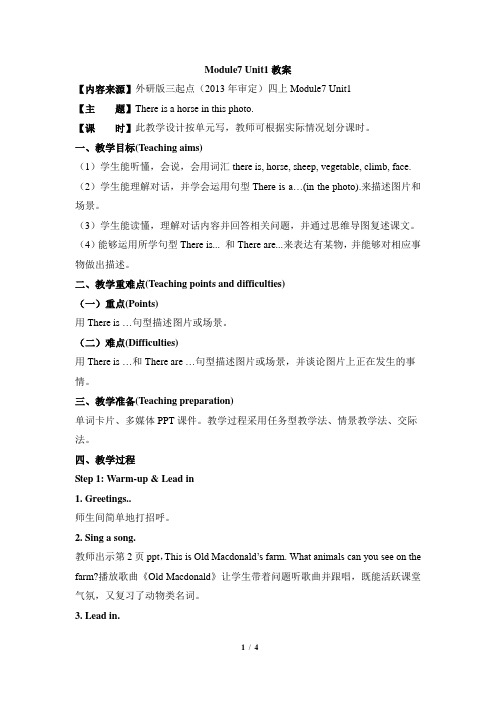
Module7 Unit1教案【内容来源】外研版三起点(2013年审定)四上Module7 Unit1【主题】There is a horse in this photo.【课时】此教学设计按单元写,教师可根据实际情况划分课时。
一、教学目标(Teaching aims)(1)学生能听懂,会说,会用词汇there is, horse, sheep, vegetable, climb, face. (2)学生能理解对话,并学会运用句型There is a…(in the photo).来描述图片和场景。
(3)学生能读懂,理解对话内容并回答相关问题,并通过思维导图复述课文。
(4)能够运用所学句型There is... 和There are...来表达有某物,并能够对相应事物做出描述。
二、教学重难点(Teaching points and difficulties)(一)重点(Points)用There is …句型描述图片或场景。
(二)难点(Difficulties)用There is …和There are …句型描述图片或场景,并谈论图片上正在发生的事情。
三、教学准备(Teaching preparation)单词卡片、多媒体PPT课件。
教学过程采用任务型教学法、情景教学法、交际法。
四、教学过程Step 1: Warm-up & Lead in1. Greetings..师生间简单地打招呼。
2. Sing a song.教师出示第2页ppt,This is Old Macdonald’s farm. What animals can you see on the farm?播放歌曲《Old Macdonald》让学生带着问题听歌曲并跟唱,既能活跃课堂气氛,又复习了动物类名词。
3. Lead in.出示第3-6页ppt,请学生根据歌曲中Old Macdonald农场中出现的动物,回答“What is the …doing?”学生用进行时态来说一说图中动物们的动作,复习之前学过的现在进行时。
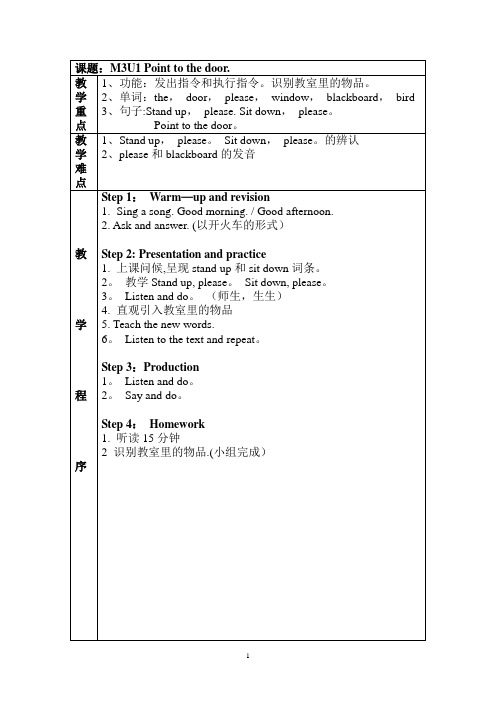
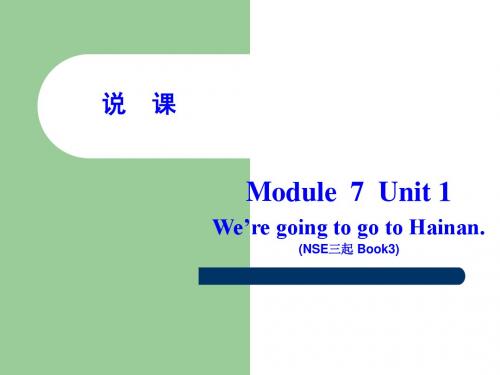

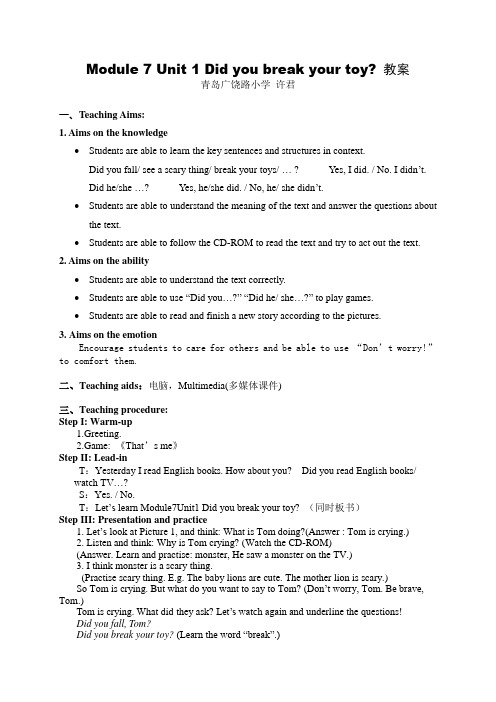
Module 7 Unit 1 Did you break your toy? 教案青岛广饶路小学许君一、Teaching Aims:1. Aims on the knowledge•Students are able to learn the key sentences and structures in context.Did you fall/ see a scary thing/ break your toys/ … ? Yes, I did. / No. I didn’t.Did he/she …? Yes, he/she did. / No, he/ she didn’t.•Students are able to understand the meaning of the text and answer the questions about the text.•Students are able to follow the CD-ROM to read the text and try to act out the text. 2. Aims on the ability•Students are able to understand the text correctly.•Students are able to use “Did you…?”“Did he/ she…?” to play games.•Students are able to read and finish a new story according to the pictures.3.Aims on the emotionEncourage students to care for others and be able to use “Don’t worry!”to comfort them.二、Teaching aids:电脑,Multimedia(多媒体课件)三、Teaching procedure:Step I: Warm-up1.Greeting.2.Game: 《That’s me》Step II: Lead-inT:Yesterday I read English books. How about you? Did you read English books/ watch TV…?S:Yes. / No.T:Let’s learn Module7Unit1 Did you break your toy? (同时板书)Step III: Presentation and practice1. Let’s l ook at Picture 1, and think: What is Tom doing?(Answer : Tom is crying.)2. Listen and think: Why is Tom crying? (Watch the CD-ROM)(Answer. Learn and practise: monster, He saw a monster on the TV.)3. I think monster is a scary thing.(Practise scary thing. E.g. The baby lions are cute. The mother lion is scary.)So Tom is crying. But what do you want to say to Tom? (D on’t worry, Tom. Be brave, Tom.)Tom is crying. What did they ask? Let’s watch again and underline the questions!Did you fall, Tom?Did you break your toy? (Learn the word “break”.)Did you see a scary thing?4. T: Let’s ask Tom together!T&Ss ask Tom together:Did you fall, Tom? (教师点击Tom图片,出现Tom回答的声音:No, I didn’t.)Did you break your toy? (教师点击Tom图片,出现Tom回答的声音:No, I didn’t.)Did you see a scary thing? (教师点击Tom图片,出现Tom回答的声音:Yes, I did.)5. Look and answer the questions. (生扮演Tom,模仿Tom的语音语调来回答。
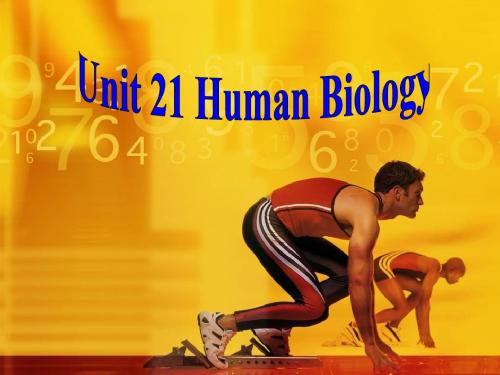
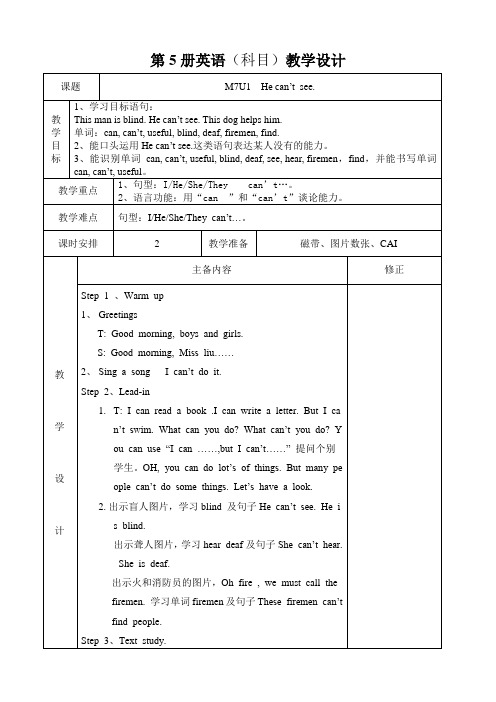
课题M7U1 He can‟t see.教学目标1、学习目标语句:This man is blind. He can‟t see. This dog helps him.单词:can, can‟t, useful, blind, deaf, firemen, find.2、能口头运用He can‟t see.这类语句表达某人没有的能力。
3、能识别单词can, can‟t, useful, blind, deaf, see, hear, firemen,find,并能书写单词can, can‟t, useful。
教学重点1、句型:I/He/She/They can’t…。
2、语言功能:用“can”和“can’t”谈论能力。
教学难点句型:I/He/She/They can‟t…。
课时安排 2 教学准备磁带、图片数张、CAI教学设计主备内容修正Step 1 、Warm up1、 GreetingsT: Good morning, boys and girls.S: Good mor ning, Miss liu……2、Sing a song I can‟t do it.Step 2、Lead-in1. T: I can read a book .I can write a letter. But I can‟t swim. What can you do? What can‟t you do? You can use “I can ……,but I can‟t……” 提问个别学生。
OH, you can do lot‟s of things. But many peop le can‟t do some things. Let‟s have a look.2. 出示盲人图片,学习blind 及句子He can‟t see. He is blind.出示聋人图片,学习hear deaf及句子She can‟t hear.She is deaf.出示火和消防员的图片,Oh fire , we must call thefiremen. 学习单词firemen及句子These firemen can‟tfind people.Step 3、Text study.教学设计主备内容修正1、出示电视节目图片T: Boys and girls, look, this is a programme. 学习生词programmeT: W hat‟s the programme about ?S: It‟s a programme about dogs.2、出示图片,师生一起填空,采取多种方法读句子。
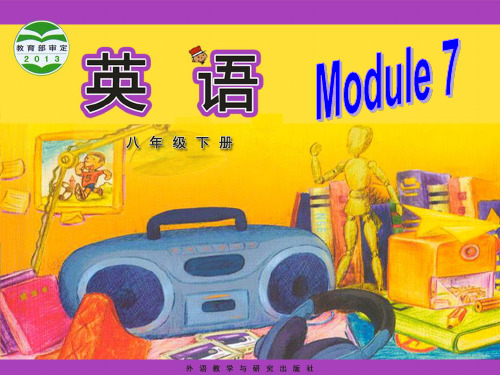
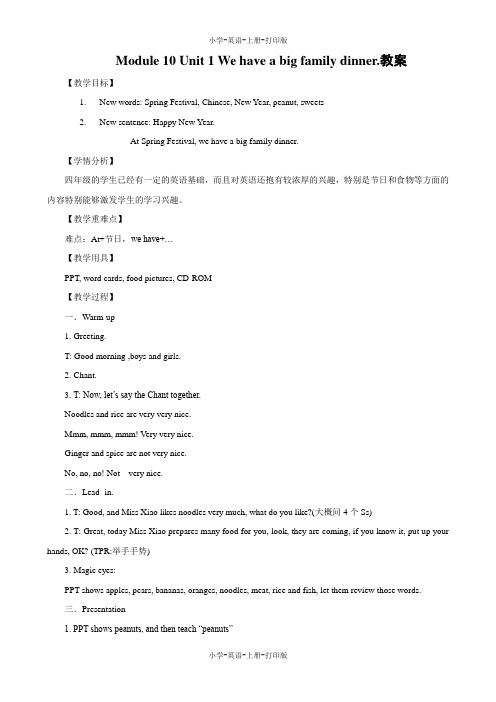
Module 10 Unit 1 We have a big family dinner.教案【教学目标】1.New words: Spring Festival, Chinese, New Year, peanut, sweets2.New sentence: Happy New Year.At Spring Festival, we have a big family dinner.【学情分析】四年级的学生已经有一定的英语基础,而且对英语还抱有较浓厚的兴趣,特别是节日和食物等方面的内容特别能够激发学生的学习兴趣。
【教学重难点】难点:At+节日,we have+…【教学用具】PPT, word cards, food pictures, CD-ROM【教学过程】一.Warm-up1. Greeting.T: Good morning ,boys and girls.2.Chant.3.T: Now, let’s say the Chant together.Noodles and rice are very very nice.Mmm, mmm, mmm! Very very nice.Ginger and spice are not very nice.No, no, no! Not very nice.二.Lead -in.1. T: Good, and Miss Xiao likes noodles very much, what do you like?(大概问4个Ss)2. T: Great, today Miss Xiao prepares many food for you, look, they are coming, if you know it, put up your hands, OK? (TPR:举手手势)3. Magic eyes:PPT shows apples, pears, bananas, oranges, noodles, meat, rice and fish, let them review those words.三.Presentation1. PPT shows peanuts, and then teach “peanuts”2.Practise:High and low. Write down peanuts on the Bd.3. PPT shows sweets, then teach “sweets”4. Practice: Step reading, then write down “sweets” on the Bd.4. T: Good job. Miss Xiao prepare a prize for you, guess, what’s it? (红包露出小部分)引导学生说出红包,并教授“red pocket”.5T:Great. Do you know when do we have red pocket?引导学生说出Spring Festival,并教授spring festival.Festival(一定要慢慢的读,特别是/v/的发音),操练:train,train,go,go ,go.Spring(也需要放慢速度,并注意/sb/的发音),操练:row by row然后再把SP连起来,带读三遍。